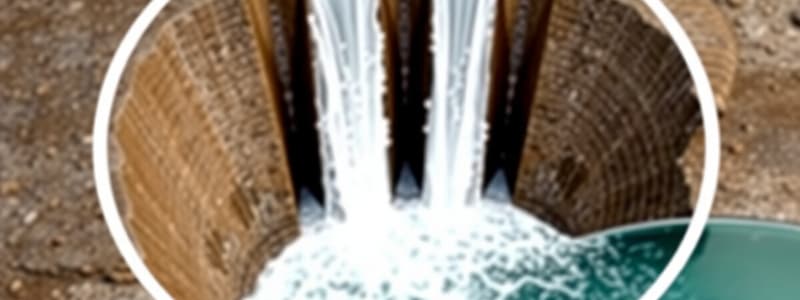Podcast
Questions and Answers
What does hydraulic radius specifically measure in a rock structure?
What does hydraulic radius specifically measure in a rock structure?
- The age of the rock formation
- The point where rock begins to cave under stress (correct)
- The total mass of the rock
- The point of erosion on the surface
Which formula correctly represents the concept of hydraulic radius?
Which formula correctly represents the concept of hydraulic radius?
- HR = volume/area
- HR = area^2/perimeter
- HR = perimeter/area
- HR = area/perimeter (correct)
What factors are necessary to determine the hydraulic radius?
What factors are necessary to determine the hydraulic radius?
- Area and perimeter (correct)
- Volume and weight
- Surface area and temperature
- Height and density
Which of the following factors does NOT directly affect the hydraulic radius?
Which of the following factors does NOT directly affect the hydraulic radius?
In what scenario would understanding hydraulic radius be most critical?
In what scenario would understanding hydraulic radius be most critical?
Which factor is NOT a consideration when selecting a mining method?
Which factor is NOT a consideration when selecting a mining method?
Which underground mining method is categorized as unsupported?
Which underground mining method is categorized as unsupported?
What primarily dictates the economic cut-off grade in mining?
What primarily dictates the economic cut-off grade in mining?
Which of the following mining methods is considered artificially supported?
Which of the following mining methods is considered artificially supported?
In the context of mining, optimizing process plant and recoveries mainly involves...
In the context of mining, optimizing process plant and recoveries mainly involves...
What is a significant characteristic of block caving as a mining method?
What is a significant characteristic of block caving as a mining method?
Sub-level open stoping mining requires which of the following conditions?
Sub-level open stoping mining requires which of the following conditions?
Which method is suitable for tabular orebodies with a dip less than 30°?
Which method is suitable for tabular orebodies with a dip less than 30°?
What role does broken rock play in shrinkage stoping?
What role does broken rock play in shrinkage stoping?
What is a necessary condition for successful sub-level caving?
What is a necessary condition for successful sub-level caving?
Flashcards
Hydraulic Radius
Hydraulic Radius
The ratio of the cross-sectional area of a flowing fluid to its wetted perimeter.
Hydraulic Radius Formula
Hydraulic Radius Formula
HR = Area / Perimeter
Area (in HR)
Area (in HR)
Cross-sectional area of the fluid.
Perimeter (in HR)
Perimeter (in HR)
Signup and view all the flashcards
Hydraulic Radius Application
Hydraulic Radius Application
Signup and view all the flashcards
Mining Method Selection
Mining Method Selection
Signup and view all the flashcards
Naturally Supported Mining
Naturally Supported Mining
Signup and view all the flashcards
Artificially Supported Mining
Artificially Supported Mining
Signup and view all the flashcards
Unsupported Mining
Unsupported Mining
Signup and view all the flashcards
Factors Affecting Mining Method Choice
Factors Affecting Mining Method Choice
Signup and view all the flashcards
Block Caving
Block Caving
Signup and view all the flashcards
Sub-Level Caving
Sub-Level Caving
Signup and view all the flashcards
Sub-level Open Stoping (SLOS)
Sub-level Open Stoping (SLOS)
Signup and view all the flashcards
Drift and Fill Mining
Drift and Fill Mining
Signup and view all the flashcards
Shrinkage Stoping
Shrinkage Stoping
Signup and view all the flashcards
Study Notes
Hydraulic Radius Definition
- Hydraulic radius (HR) is a measure used in hydraulics and related fields.
- It describes the relationship between the cross-sectional area of flow and the wetted perimeter of a channel or conduit.
- It is specifically defined as the ratio of the cross-sectional area of flow to the wetted perimeter.
Formula
- The formula for calculating hydraulic radius is: HR = Area / Perimeter
- Where:
- HR is the hydraulic radius
- Area is the cross-sectional area of the flowing fluid
- Perimeter is the wetted perimeter of the channel or conduit.
Application in Geotechnical Engineering (Cave-in)
-
The provided text incorrectly implies that hydraulic radius is a point where rock caves in. This interpretation is not accurate.
-
The concept of hydraulic radius, in a geotechnical engineering context of rock stability, is not directly about the point of cave-in. Hydraulic radius calculations are more commonly applied to the analysis of flow in open channels and conduits.
-
Cave-ins are determined by different factors like:
- Rock type and strength
- Geometry and orientation of the rock mass.
- Stress conditions (in situ stress, excavation stress).
- Support systems (presence and type of shoring).
- The presence and geometry of any fractures or discontinuities in the rock.
- The total weight of the overlying material, which puts downward stress on the rock mass.
-
While the relationship between water flow and rock stability can exist, it's not directly described by the hydraulic radius.
Studying That Suits You
Use AI to generate personalized quizzes and flashcards to suit your learning preferences.




